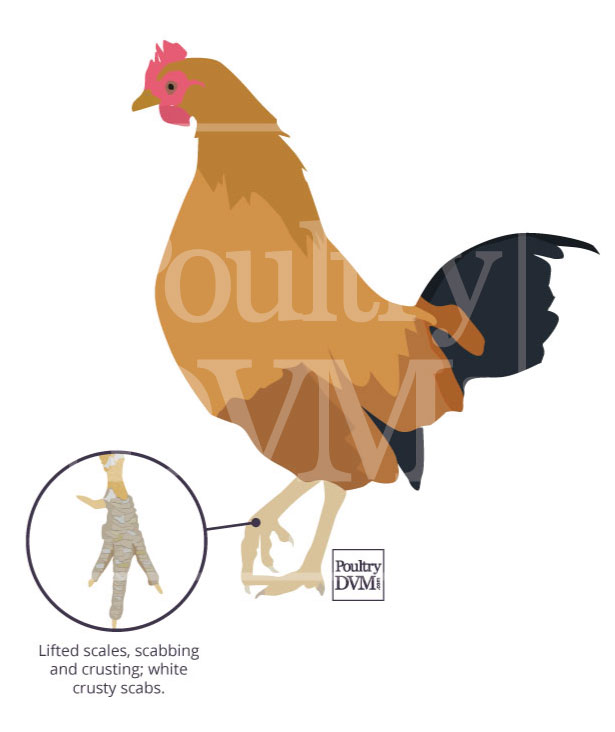Scaly leg mites (
Knemidocoptes mutans) are a relatively common ectoparasite found in adult backyard chickens, turkeys, and pheasants worldwide. These mites are extremely tiny (not visible to the naked eye) and will spend their entire lives (10 to 14 days) burrowing tunnels underneath the cornified epidermis of the chicken’s skin.
K. mutans are normally found on the chicken’s legs and top of their feet, but on occasion may invade the comb, wattles, neck and/or beak. The tunneling action of the mites is damaging to the chicken’s skin tissue, resulting in hyperkeratotic lesions which appear as thickened, scaly skin, raised non-uniform scales, white crusting and seepage of tissue fluid. The presence of the mites is also very irritating and painful for the bird. Left untreated, it can lead to necrosis of the toes, lameness, and deformation of the legs and feet. Chickens infested with scaly leg mites have an increased risk of developing secondary bacterial infections due to the destruction of the skin barrier which if intact would help protect them invasion with harmful pathogens.
Transmission of Scaly Leg Mites
Scaly leg mites are spread between birds by direct contact with infected flock members. They are initially introduced into the flock through wild birds, rodents, or by already being present within the soil and surrounding environment.
Clinical Signs of Scaly Leg Mites in Chickens
Early signs of invasion with scaly leg mites in chickens are the appearance of flaking, scaly, crusting, and/or thickening of the skin on their legs and top of their feet. A normal, healthy chicken should have bright, smooth, uniform scales.
The scales of chickens infested with scaly leg mites will appear roughened, non-uniform, raised, and some may protrude upwards. If left untreated, parts of chicken's toes may slough off and the heavy crusting of the scales can start to interfere with joint flexion, resulting in lameness and deformity.
Diagnosis of Scaly Leg Mites
A diagnosis can be made by microscopic identification of the mites in skin scrapings, though clinical signs may be sufficient diagnostic in some cases.
Treatment of Scaly Leg Mites in Chickens
In order to initially suffocate the mites and help promote growth of new scales, paraffin oil or petroleum jelly (Vaseline) is applied to the legs and feet of each infected bird. Repeated daily until the old, damaged scales have fallen off, and new healthy scales have grown in. In moderate to severe cases, administration of 1% Ivermectin or Moxidectin is needed.

